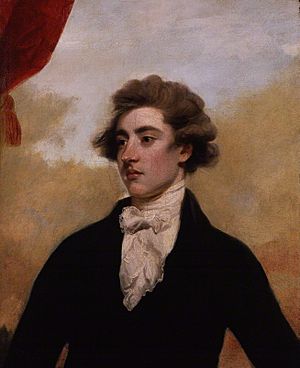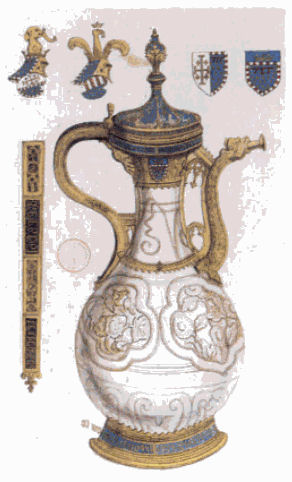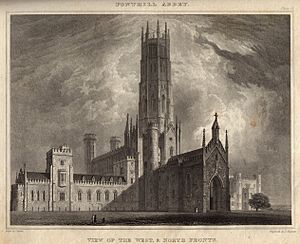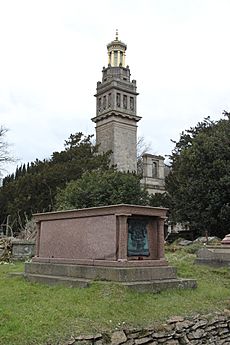William Beckford (novelist) facts for kids
Quick facts for kids
William Beckford
|
|
|---|---|
 |
|
| Born | 29 September 1760 Soho Square, London, England
|
| Died | 2 May 1844 (aged 83) Bath, Somerset, England
|
| Nationality | English |
| Occupation | Writer, art collector, politician |
|
Notable work
|
Vathek (c. 1781); Memoirs of Extraordinary Painters (1780); Letters from Italy with Sketches of Spain and Portugal (1835) |
William Thomas Beckford (born September 29, 1760 – died May 2, 1844) was an English writer, art collector, and politician. He was known for being one of England's wealthiest people at one point. William Beckford wrote the famous Gothic novel Vathek. He also built impressive buildings like Fonthill Abbey and Beckford's Tower. He was also famous for his huge collection of art.
Contents
William Beckford's Early Life
Beckford was born in London on September 29, 1760. His family lived in a home at 22 Soho Square. When he was just ten years old, he inherited a very large fortune from his father, William Beckford. His father had been the Lord Mayor of London twice. This fortune included a lot of money and large estates, including Fonthill in Wiltshire. It also included several sugar plantations in Jamaica.
This great wealth allowed William Beckford to follow his passions. He loved art, architecture, and writing. For a short time, he even had music lessons from the famous composer Wolfgang Amadeus Mozart. His drawing teacher, Alexander Cozens, had a bigger impact on him. Beckford continued to write to Cozens for many years.
On May 5, 1783, Beckford married Lady Margaret Gordon. She was the daughter of the fourth Earl of Aboyne.

Travels and Writings
Beckford studied with famous architects and artists. He traveled to Italy in 1782. After his trip, he wrote a book about his experiences called Dreams, Waking Thoughts and Incidents (1783).
His most famous book, the Gothic novel Vathek, came out in 1786. He wrote it originally in French. Beckford liked to say he wrote the whole book in just three days and two nights. However, this might have been an exaggeration!
Other important writings by Beckford include Memoirs of Extraordinary Painters (1780). This was a funny, satirical book. He also wrote Letters from Italy with Sketches of Spain and Portugal (1834). This book had wonderful descriptions of the places he visited. In 1793, he visited Portugal and lived there for a while.
Beckford's fame comes not only from his books. It also comes from his unique personality. He was known for his love of building and collecting. He spent a lot of his fortune on these projects. At one point, his income was estimated to be £100,000 a year. By the time he died, only £80,000 of his original money was left.
William Beckford's Art Collection

William Beckford was a very active collector. He bought and sold artworks often. Sometimes, he would even buy back pieces he had sold before! His collection was special because it included many Italian paintings from the 1400s. These were not commonly collected back then and were not very expensive.
Even though he liked medieval styles, he owned few medieval artworks. Most of his collection was from the Renaissance period. He also liked fancy Asian objects, like carvings from the Mughal Empire. Unlike many English collectors, he did not focus on classical marble statues. Instead, he collected a lot of 18th-century French furniture and decorative items. These were very expensive at the time.
He bought a painting by J. M. W. Turner in 1800, when Turner was only 25. He also bought drawings by William Blake in 1828. However, he generally preferred older artworks.
By 1822, Beckford was running low on money and had debts. He decided to sell Fonthill Abbey. Christie's, the auction house, sold 72,000 copies of the catalogue for the sale. Many visitors came from London to see the items before the sale. Fonthill, along with some of his collection, was sold to John Farquhar for £330,000. Farquhar then auctioned off the art and furniture in 1823. Beckford and his son-in-law bought many items back, often for less than Beckford had paid originally.
The rest of his collection was kept at Lansdown Tower. This became almost a second collection. It was later inherited by the Dukes of Hamilton. Much of that collection was sold in a big auction in 1882.
Today, many pieces from Beckford's collection are in museums around the world.
Famous Artworks Once Owned by Beckford
Here are some artworks that were once part of William Beckford's collection:
- Saint Catherine of Alexandria by Raphael (now in the National Gallery, London)
- Agony in the Garden by Giovanni Bellini (now in the National Gallery, London)
- Portrait of Doge Leonardo Loredan by Giovanni Bellini (now in the National Gallery, London)
- Exhumation of Saint Hubert by Rogier van der Weyden (now in the National Gallery, London)
- Philip IV in Brown and Silver by Diego Velázquez (now in the National Gallery, London)
- The Sermon on the Mount by Claude Lorrain (now in the Frick Collection)
- Doge Giovanni Mocenigo by Gentile Bellini (now in the Frick Collection)
- The Fonthill Vase, a 14th-century Chinese porcelain vase (now in the National Museum of Ireland)
- The Byzantine agate Rubens Vase (now in the Walters Art Museum)
Fonthill Abbey: Beckford's Grand Home

William Beckford bought the entire library of Edward Gibbon. This gave him a great start for his own library. He then hired the architect James Wyatt to build Fonthill Abbey. This grand building was meant to hold his books and art collection.
The famous Lord Nelson visited Fonthill Abbey in 1800. The house was finished in 1807. Beckford became a Member of Parliament for Wells and later for Hindon. However, he mostly lived a private life. He spent much of his inherited wealth on his projects.
In 1822, he sold Fonthill Abbey to John Farquhar for £330,000. He then moved to Bath. There, he bought several houses and connected them. Sadly, most of Fonthill Abbey collapsed on December 21, 1825. This happened because its tall tower was not built very well. Only a small part of the abbey remains today as a private home.
Lansdown Crescent and Beckford's Tower
Beckford spent his later years living in Lansdown Crescent in Bath. During this time, he asked architect Henry Goodridge to design a spectacular building. This building was a "folly," a decorative building with no real purpose. It was built at the northern end of his land on Lansdown Hill. This building is now known as Beckford's Tower. He kept many of his treasures inside it.
Today, Beckford's Tower is owned by the Bath Preservation Trust. It is managed as a museum about William Beckford. Part of the property can even be rented for holidays. The museum shows pictures of the Tower's original inside. It also has furniture that Beckford ordered specially for the Tower. You can learn a lot about Beckford's life in Bath and at Fonthill there.
William Beckford died at Lansdown Crescent on May 2, 1844, when he was 84 years old. He wanted to be buried in the grounds of Lansdown Tower. His body was first buried in Bath Abbey Cemetery. Later, in 1848, his younger daughter bought the land around the Tower. She had it made into a cemetery. This allowed Beckford's remains to be moved and buried near the Tower he loved so much.
Beckford designed his own tomb. It is a large stone coffin made of polished pink granite. It has bronze plaques with his family's symbols. It stands on a small hill in the cemetery. On one side, there is a quote from his book Vathek: "Enjoying humbly the most precious gift of heaven to man – Hope."
The cemetery is now closed for new burials. However, it is still open to the public. The Tower is also open on certain days of the year.
Other Works by Beckford
As a writer, Beckford is best known for Vathek. This book was very well received. He also wrote his travel memoir, Italy: with some Sketches of Spain and Portugal.
He wrote two funny books that made fun of popular writing styles. These were Modern Novel Writing, or, The Elegant Enthusiast (1796) and Azemia. He also published Biographical Memoirs of Extraordinary Painters (1780). This was a playful book that made fun of serious biographies. Near the end of his life, he published collected travel letters. These were called Recollections of an Excursion to the Monasteries of Alcobaca and Batalha (1835). This book was about a trip he took in 1794.
William Beckford's Legacy
Beckford had two daughters. His younger daughter, Susanna Euphemia, married Alexander Hamilton, 10th Duke of Hamilton. She inherited most of his art collection. This collection was then moved to Hamilton Palace.
Beckford has been featured in biographies and even a TV show. He also wrote a lot of music. Many of his music papers are now kept at the Bodleian Library. His music includes a collection of Portuguese songs called Modinhas Brasileiras. These are very important because they are some of the earliest examples of this type of song.
See also
 In Spanish: William Beckford para niños
In Spanish: William Beckford para niños
- List of horror fiction authors
Sources
- "Davies": National Gallery Catalogues: Catalogue of the Earlier Italian Schools, Martin Davies, National Gallery Catalogues, London 1961, reprinted 1986, ISBN: 0-901791-29-6
- Getty Provenance Research databases (Public collections etc.)
- Reitlinger, Gerald; The Economics of Taste, Vol I: The Rise and Fall of Picture Prices 1760–1960, Barrie and Rockliffe, London, 1961



